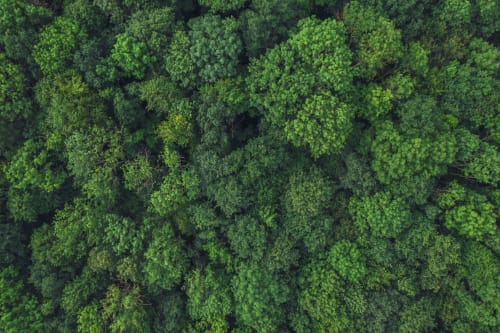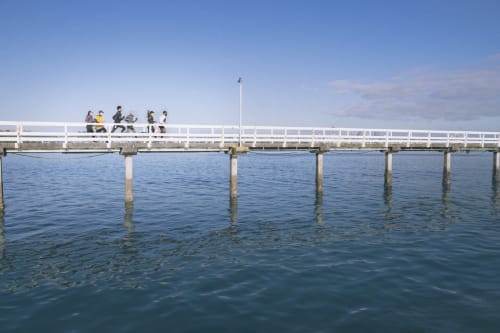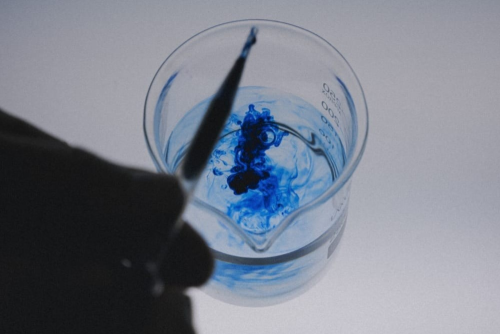why nature matters

Our relationship with nature is one of both dependence and responsibility. We rely on materials like cotton, leather, and rubber to create our products, yet our direct and indirect operations affect ecosystems through water use, emissions, and chemicals. That’s why we’re committed to three key areas: safeguarding biodiversity, sustaining water resources, and increasing responsible chemical use, which includes reducing hazardous substances, improving chemicals monitoring, and working with industry partners to drive the development of safer alternatives.
We are actively implementing initiatives and partnerships to drive progress across biodiversity, water, and chemicals management.
BIODIVERSITY: OUR APPROACH
BIODIVERSITY: OUR APPROACH
Biodiversity is essential to the ecosystems we depend on, but it faces growing pressure from deforestation, land conversion, and resource over-extraction. At adidas, we are managing our impact on biodiversity throughout our value chain, focusing especially on improving our sourcing of natural materials like cotton, leather, and rubber. To protect biodiversity, we do not source raw materials from endangered and/or threatened species and have put in place specific rules for animal-derived materials. For more information, please see our animal-derived materials standard.
Our approach to biodiversity follows the Science Based Targets Network (SBTN) framework, which guides us through three key steps:
1. Assess impacts in our value chain
We start by understanding our impact across our value chain by tracing our materials and identifying any risks to biodiversity along the way. This assessment extends beyond our own operations, also taking our sourcing and strategic supplier locations into account. These insights drive our strategy and inform targeted actions.
2. Avoid and reduce impacts
We reduce impacts by collecting additional due diligence information and using certification for our materials, while reducing virgin raw material consumption. This includes increasing recycled content and investing in the research of new materials that have the potential to lower our environmental footprint.

BIODIVERSITY AND ECOSYSTEMS POLICY
Our Biodiversity and Ecosystems policy addresses adidas’ commitment to reduce pressure on biodiversity, specifically on protected and endangered natural ecosystems, including respecting the rights of local communities. adidas is committed to no deforestation, conversion and degradation in the supply chains which we source from, and to the protection and restoration of biodiversity and ecosystems (including Ancient and Endangered Forests) affected by our business operations.
Read the full policy here.
key biodiversity initiatives
Understanding biodiversity risks in our own operations

We want to ensure that the locations of our offices and distribution centers are not conflicting with biodiversity-sensitive areas. Therefore we use internationally recognized tools like the Integrated Biodiversity Assessment Tool (IBAT), including the Species Threat Abatement and Restoration (STAR) metric, to see how our operations might impact the local environment. This helps us to identify areas where we can improve and take proactive steps to minimize our footprint. For more details on our biodiversity assessments, see our 2024 annual report. These assessments are shared locally and included in our Integrated Management System (IMS), as part of our certification systems such as ISO 14001.
Our IMS supports securing key ISO certifications across our locations, ensuring compliance with environmental, health & safety, and energy management standards.
Traceability and supply chain transparency

We map our value chain to develop an understanding of our social and environmental impact.
- Mapping our materials supply chain: We map natural materials like leather, man-made cellulosic fibers (MMCF) and natural rubber across our supply chain. This helps us understand where our materials come from to understand the potential impacts caused by them. In 2023/2024, we collaborated with our strategic suppliers to trace our bovine leather all the way back to the slaughterhouse and – in some cases – to individual farms. We've also mapped our natural rubber and MMCF supply chains down to the extraction and production of raw materials (T4). This helped to identify potential challenges and address them accordingly.
- Working with suppliers: We are sharing our ambitions and targets on deforestation- and conversion-free supply chains with our suppliers and are working with them to find solutions together to address our commitments.
- Connecting social and environmental responsibility: We integrate social considerations into all our biodiversity initiatives, ensuring that rights of local communities are respected when changes to natural ecosystems occur. Learn more about our commitment to human rights.
Cross-industry collaboration and initiatives

We know that safeguarding biodiversity requires more than just individual action and that it is only through collective effort that we can drive the systemic change needed to make a difference. This is why we're involved in various initiatives that promote sustainable practices across industries, centered on the following topics:
- Transparency in the leather value chain: In addition to our collaboration with the Leather Working Group (LWG) und Textile Exchange (TE) as part of the “Deforestation-free Call to Action for Leather”, we also support local initiatives such as the Certification of Origin and Traceability Implementation Initiative (COTI) to improve transparency in our leather supply chains.
- Steps towards regenerative agriculture: We contribute to industry standards for regenerative agriculture, which helps to restore ecosystems and promote healthier environments. adidas is also a founding member of the ‘Unlock’ program, a non-profit, cross-industry initiative led by The Fashion Pact, designed to decarbonize raw materials production and catalyze a shift to regenerative farming.
- Responsible Sourcing: We source our materials according to a range of credible certification schemes to ensure our materials meet the highest environmental and social standards. Visit the Materials section to learn about the specific certifications.
WATER: OUR APPROACH
WATER: OUR APPROACH
Water is essential for life, and at adidas, we're committed to using it responsibly. We focus on reducing our water footprint by increasing efficiency in our own operations and supply chain, and ensuring the water discharged is clean and safe.
We take a collaborative approach to water stewardship, working with our suppliers to ensure responsible water use through target-setting, enhancing wastewater quality, and implementing key water initiatives. Through continuous improvement and water management practices, we aim to minimize our environmental impacts related to freshwater.
KEY WATER INITIATIVES
Improving water efficiency

Improving water efficiency in our own operations
We're committed to using water responsibly in our own offices, distribution centers, and production sites. We're always looking for ways to reduce our water footprint. And we are making good progress: By 2024, we had already achieved a 17% reduction in water intensity across our own operations (baseline: 2019), meeting our 2025 target ahead of schedule.
Improving water efficiency in our supply chain
Collaborating closely with our suppliers, we have been monitoring their water consumption, implementing water-saving initiatives, and driving efficiency improvements.
We have established water intensity reduction targets to reduce the water footprint of our Tier 1 and Tier 2 suppliers. All our suppliers have installed water meters at workshop level to identify consumption hotspots and implement saving practices, such as investing in low-liquid ration dyeing machines. We continue to reduce the freshwater consumption, particularly in high water-impact Tier 2 facilities, with the aim of achieving a 40% reduction by 2025 (baseline 2017).
Assessing water risks across our value chain

We conduct an annual supply chain water risk mapping to identify water risks in our own operations and our key supplier locations. By using World Resources Institute’s (WRI) Aqueduct tool, we look at physical, reputational, and regulatory water-related risks. The results of this risk assessment support our decisions when it comes to target-setting and choosing the right water projects in our value chain.
Clean water

We are committed to clean water to preserve healthy natural habitats. We work closely with industry stakeholders and suppliers to enhance the quality of water discharge. As a signatory member of Zero Discharge of Hazardous Chemicals (ZDHC) group, we contributed to the development of the ZDHC Wastewater Guidelines – an industry standard aimed at harmonizing the process, test methods, and requirements. Since 2017, our suppliers have fully adopted this industry standard, and their wastewater performance is publicly disclosed on third party platforms such as IPE DETOX and ZDHC Gateway portal. To support our suppliers in meeting the ZDHC requirements, we have partnered with Sustainable Textile Solution (STS) to improve their wastewater treatment plant technology. This partnership helps us fulfil our wastewater targets. See more in our Targets section.
CHEMICAL MANAGEMENT: OUR APPROACH
CHEMICAL MANAGEMENT: OUR APPROACH
Chemicals play a critical role in apparel and footwear production, but we recognize their potential impact on the environment and people. To develop high-performance products with lower environmental impact, we pursue the adoption of safer chemicals. At adidas, we implement a holistic chemical management approach across our supply chain, which is crucial to eliminating hazardous substances and minimizing the risks and hazards to the environment and people. We aim to effectively monitor the chemicals being introduced into the input process at our manufacturing facilities, together with sound output wastewater management control, to prevent the release of hazardous substances into the environment.
We see the need for pragmatic and implementable chemical management guidance for our suppliers that can be used to reduce the environmental footprint in our supply chain. As signatory member of Zero Discharge of Hazardous Chemicals (ZDHC), we work closely with industry partners to develop harmonized guidelines and tools, such as the Manufacturing Restricted Substances List (MRSL) and Wastewater Guidelines, for our supply chain partners. These programs are implemented and regularly verified to ensure that best practices and the existing chemical management tools are truly applied in our supply chain.
In addition, we enforce stringent measures through our adidas A-01 Restricted Substances List and conduct regular testing of materials, products and supplier facilities to ensure the absence of restricted chemical substances to protect the health and well-being of our customers and uphold our environmental stewardship.
Explore our latest report for detailed information on our chemical management progress reports.
Adopting the highest conformance chemicals

Since 2015, we have been adhering to the ZDHC Manufacturing Restricted Substances List (MRSL) and its conformance guidance, establishing a strong foundation for the industry harmonization of the input chemical management. We have also defined a strategic five-year plan for our suppliers to adopt chemicals that meet the highest ZDHC MRSL conformance level 3. In addition, we effectively monitor the introduction of chemicals throughout our supply chain.
Catalyzing chemical transparency, while fostering collaboration

To increase the adoption of the highest conformance chemicals within our complex supply chain, we have established a robust measurement and tracking system to capture chemical inventory information from our suppliers via BVE3.This system lays the foundation for effective monitoring, thereby enhancing transparency in chemical usage and identify the potential areas for streamlining to reduce the chemical usage in our production process.
Managing chemicals in a multi-tiered supply chain is complex and requires the involvement of a wide range of stakeholders to achieve effective and long-lasting solutions. Hence, we closely collaborate with different stakeholders such as ZDHC, AFIRM, ChemSec, Better Cotton, and the Leather Working Group (LWG) to develop and scale collective efforts to promote safe chemistry and low environmental impact practices within apparel and footwear industry.
Improving wastewater treatment

To reduce the environmental impact of discharged wastewater, we require our suppliers to implement the best available technology and practices in their onsite effluent treatment plant to meet ZDHC wastewater standards. Our approach includes regular monitoring, onsite advisory service and enhance treatment process. This aims to minimize the release of pollutants to environment and safeguard our ecosystem. For further information, please visit our annual report dashboard
Chemicals we do not use
Polyvinyl chloride (PVC) and phthalates
In 2000, we were one of the first companies in the global consumer goods sector to work towards the elimination of PVC from our products. Alternatives have been found and nearly all styles in our global product range are now PVC-free. There are a few countries where alternatives are not available, but in these cases we remain committed to finding a long term solution.
In 2003, we eliminated the use of polyethylene chloride, since it has a similar environmental footprint as PVC. We are also encouraging a move to printing with phthalate-free inks. Some of our business units have made the changeover in their owned facilities and more and more of their suppliers are also making the switch.
Perfluoralkyl & Polyfluoroalkyl Substances (PFAS)
adidas is committed to being more than 99% PFAS-free. In 2023, an industry-wide supplier informed us that paint containing PFAS was incorrectly used for individual components of zippers in our PFAS free apparel range. Upon learning this, we have taken appropriate steps to ensure that we will return to being 99% PFAS-free as of Fall/Winter 2024.
Perfluorinated compounds (PFCs)
In 2013, in the framework of the joint roadmap for the elimination of hazardous chemicals by 2020, we committed to phasing out the use of long-chain PFCs by no later than January 1, 2015. As a further step, we committed to being 99% PFC-free by no later than December 31, 2017. By the end of 2018, we met the further target of being more than 99% free of poly- and perfluorinated substances in our products for the fall/winter 2019 season.
Volatile organic compounds
The volatile organic compounds (VOCs) typically found in solvents used in our manufacturing process can – in high concentrations – cause breathing difficulties and other health problems for production workers. For over a decade, we have requested that our footwear suppliers significantly reduce the use of VOCs in their manufacturing. By applying innovative and environmentally sound bonding and priming technologies while following the adidas guidelines on the use of chemicals, our athletic footwear suppliers have been able to reduce the use of VOCs significantly, for example through the use of water-based primers and reactive hot-melt adhesives.
For more information on restricted substances, see our Policy for the Control and Monitoring of Hazardous Substances
Nature partnerships and collaboration
Partnerships are a big part of our work. Explore our key collaborations below:
Achievements in a flash
Canopy planet partnership (2023)
Strengthening our commitment to responsible sourcing and eliminating sourcing from ancient and endangered forests.
CDP RECOGNITION (2024)
Achieved a B rating in forests and water security disclosure themes, reflecting steady progress in these areas.
Science-Based Targets for Nature (2024)
Joined the SBTN Corporate Engagement Program to guide and validate our nature-related sustainability targets.
Textile Exchange Materials Benchmark (2024)
Achieved a score of 11 out of 15 on progress towards the deforestation-free call to action for Leather KPIs, demonstrating our progress in using preferred fibers and materials.
Champion Level in the ZDHC ‘Brands to Zero’ program (2024)
This is the second consecutive year that adidas has achieved the highest level in the ‘Brands to Zero’ program, demonstrating our effort on driving chemical management in our supplier base.
1st runner up in CITI Index (2024)
Maintains ranks in the top 3 for annual evaluations of green supply chain management among 280 companies. This evaluation covers environmental management, extending practices beyond direct business operation and enhancing transparency
Nature
Nature sustains a healthy planet. At adidas, we see how everything is connected: healthy soil nurtures biodiversity, clean water supports thriving communities, and responsible chemical use protects natural systems.
Nature
Nature sustains a healthy planet. At adidas, we see how everything is connected: healthy soil nurtures biodiversity, clean water supports thriving communities, and responsible chemical use protects natural systems.


